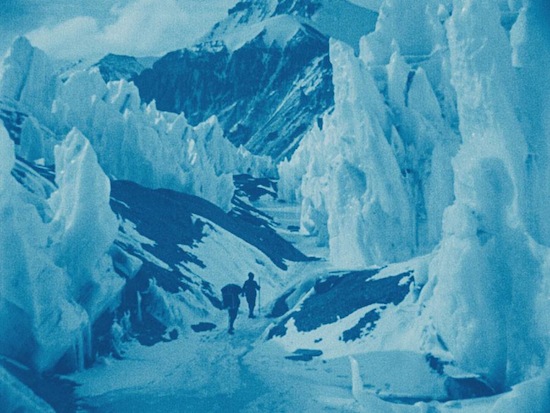In the early spring of 1924, John Noel, a First World War captain and keen mountaineer, set out with the team of British, Sherpa and Tibetan men that comprised the second Everest expedition to ascend the world’s tallest mountain. For Noel, it was the further realisation of a long-held fascination with Everest, first piqued when he had, in disguise, taken leave of his army regiment stationed in the Himalayas to reconnoitre the mountain and surrounding region in 1913. He had previously taken part in the first expedition, in 1922, taking photographs and capturing footage, and for this attempt he had bought the rights to all images and film, assuming the role of official recorder of the climb.
Over the following three months, Captain Noel would film all aspects of the expedition – the men travelling towards the Rongbuk valley and meeting the residents of Phari Dzong, glancing shots at the ancient buildings of the Khamber Jong hamlet, setting up the various camps on Everest itself – right up to images, as many as his camera, specially adapted for shooting at in harsh conditions, would permit of the three summit attempts, including George Mallory and Andrew Irvine’s final climb. After the team descended Everest on June 11, two days after Mallory and Irvine had failed to reappear from the mists shrouding the mountain’s north-eastern face, Noel assembled his footage, condensing the expedition into a poignant, concise 90-minute documentary, The Epic Of Everest.
Now, marking 100 years since Noel first saw Everest, the BFI have restored his work, adding back in the spectral colour of the original film and accompanying it with a newly-composed soundtrack from Simon Fisher Turner. The end result is nothing short of astonishing, a restoration which wholeheartedly taps into the sense of awe that lies in Noel’s silent images, pivoting on the wonderment, loneliness and sheer otherworldliness with which he imbued his visual account of the expedition.
Some of the most staggering shota are those Noel takes of the men in the initial stages of the climb. They negotiate the Rongbuk glacier, dubbing it “Fairyland” with a nod to the local belief in the presence of mythic creatures living there, a sense of the paranormal that’s never far from the surface of the film, and the hulking ice walls take on an uncanny blue luminescence on Noel’s aged film, one that reinforces the sense of Everest existing in its own, impenetrable world. Elsewhere, his static shots of the upper cols and the rocky outcrops giving way to abyss-like gullies serve to impart some of the enormity of the landscape in a way that would not, perhaps, transfer on modern high-definition film.
Turner’s score feels out the humanity in the images, whether in the lapping synths that echo the uncertainty pervading the first stages of the journey or the jubilant bells that accompany one of the pack horses’ foals finding its feet. It echoes the sheer oddity and uneasy union of human and landscape Noel’s camera passes across – Cosey Fanni Tutti’s cornet switches from gliding, aerial notes to dissonant, almost-mispitched blares with brilliant effect – with opposing sonic terrains emerging on top of one another, the life of the native folk music, performed by the Nepalese Thapa family, subsumed by the inanimacy inherent in the bassy, percussive reverberations that surround the mountain sequences. Vitally, it shares in the reverence that Noel feels for the mountain: the sense of awe at the first sighting of the peak, accompanied by a solid tranche of trumpets, is tangible.
Neither does The Epic… go in for sentimentalisation; rather Noel’s film, underlined by the score, trades in the disorientation and futility of the climbers’ knocked-back attempts at conquering the snowy ridges. As Captain Noel is keen to point out in one of his intertitles, the long-range telescopic lens shots he uses are cutting edge, but their technical shortcomings, from our standpoint, almost end up being a pay-off: the reduction of the figures to barely discernible scratches on the scarred mountain sides do more than merely point up our insignificance under the mountain, they bluntly foreshadow death, setting limbs, both human and rock, side by side.
The element that leaves the greatest resonance, perhaps, is the note the film closes on. After the starkness of Noel Odell laying down sleeping bags to form a ‘T’, the signal that hope was lost for Mallory and Irvine, comes the necessary rationalisation of their death. As they leave Everest, Noel’s intertitles relate a willingness to embrace the sacred fear in which the monks of the Rongbuk monastery hold the mountain, “LIVE and SPIRIT-GUARDED”. Even if we can’t fully share in seeing Everest, its summit successfully reached 29 years later, as being protected by some divine force, the closing images of the Mahalangur range bathed in a blood red dawn convey a sort of relinquishing for Noel and his men; that which at first seems sinister resolves into a necessary making peace with what remained, for them, indomitable.
The Epic Of Everest will be screened at Rough Trade East in London on January 17, with Captain John Noel’s daughter Sandra Noel and Simon Fisher Turner taking part in a Q&A hosted by the Quietus’ Luke Turner; head here for full details, and pre-order the DVD at the BFI’s website



